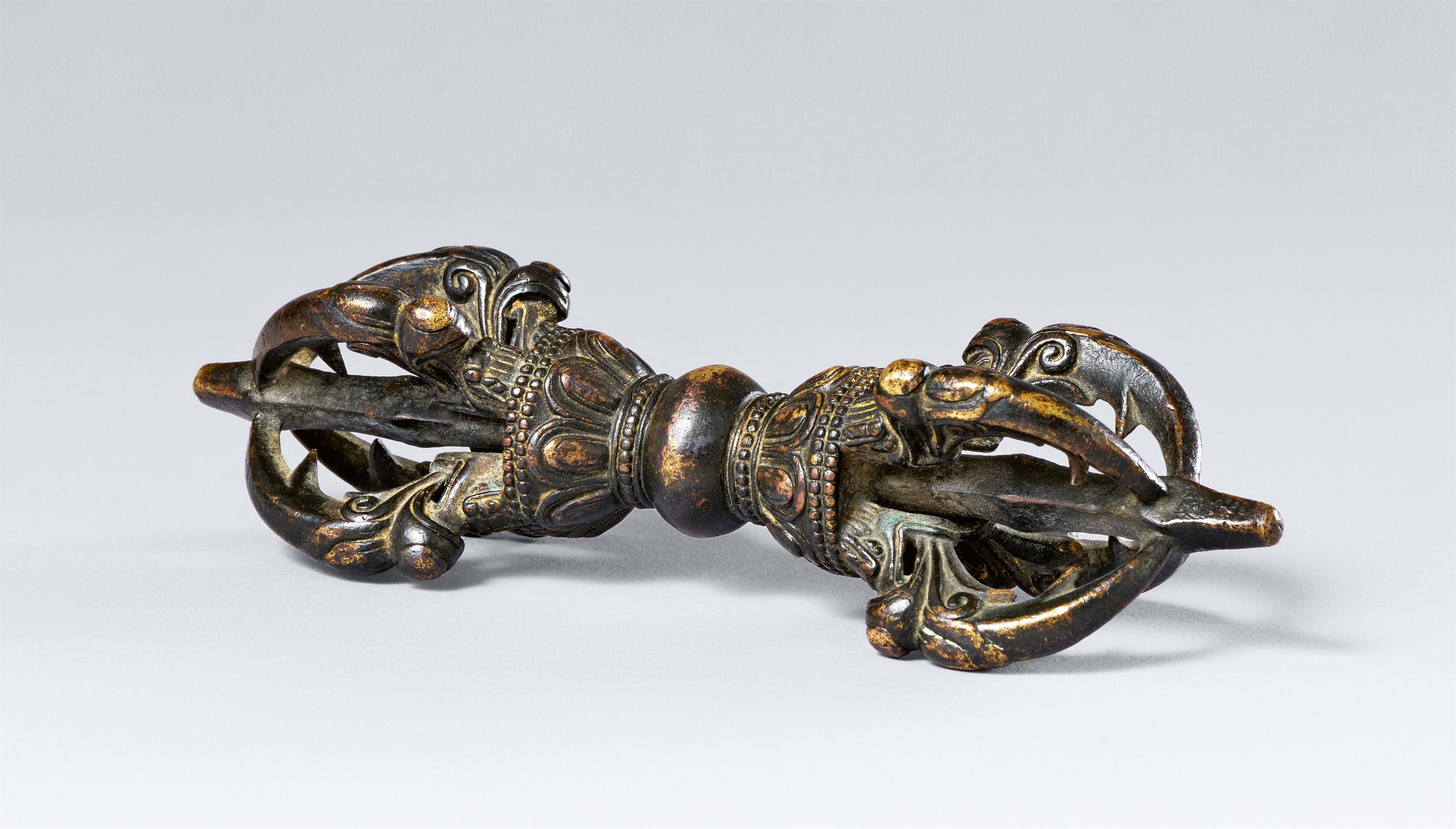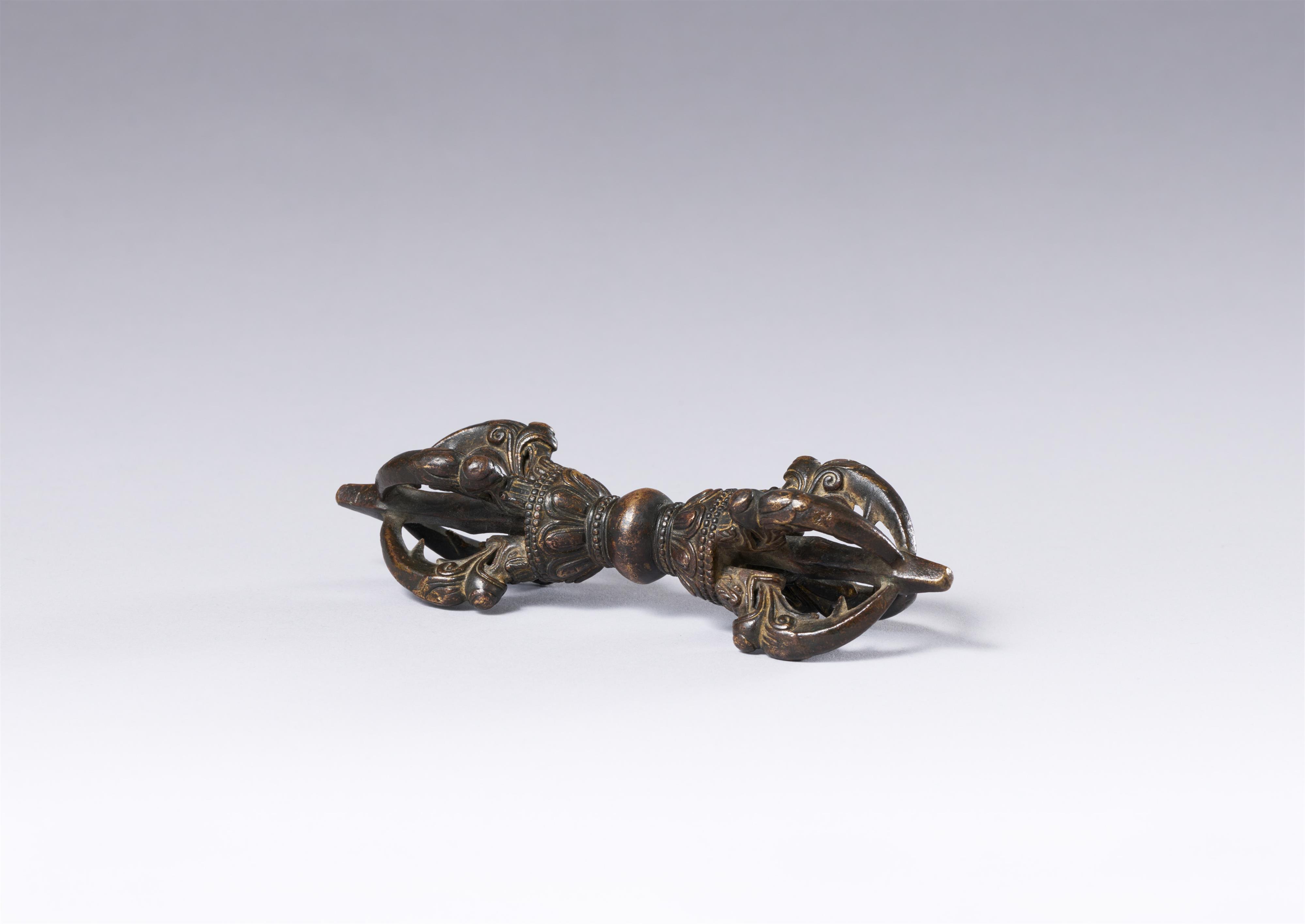A Sinotibetan bronze vajra. Ming dynasty (1368–1644)
A five-pointed vajra diamond scepter, the central section with lotus friezes centered by a rounded knob, symbolising emptiness, flanked by frieze of pearls between plain bands, surrounded by a eight-petalled lotus at either side, the fout outer curved prongs emerging from makara heads, and at either end joining the central shaft with their tips.
Length 13.1 cm
The thunderbolt (skrt. vajra, Tibet. dorje) is a historical development of the lightning sceptre of the Vedic rain and thunderstorm god Indra, who is considered the king of the gods in the Vedic scriptures. In Vajrayana and Lamaism, it symbolises the diamond nature and thus the emptiness in the existent, the indestructible and eternal absolute. It also stands for the male principle, while the bell (skrt. ghanta) as its antithesis stands for the female principle. The vajra symbolises the inseparability of emptiness and form and is the attribute in all representations of deities and the main symbol of the Vajrayana (diamond vehicle). A vajra is represented with three, five or nine spokes. The five- or nine-spoked versions are the most common in the Tantric Buddhist traditions. The nine-spoked vajra symbolises the five Buddhas of the five directions, as well as their consorts. While it is a sceptre with peaceful deities and an indestructible weapon with wrathful deities.
明 漢藏風格 銅五股金剛杵
來源:德國黑森私人收藏, 收藏于1970年代
可比: Musée national des Arts asiatiques-Guimet (著),《Rituels tibétains. Visions secrètes du Ve Dalai Lama》, 巴黎 2002年,頁137f.,圖90及Robert R. Bigler (著), 《Art and faith at the crossroads》,蘇黎士2013年, 第39號。參考北京故宮博物院藏一件銘宣德年製款金剛鈴,錄於 《清宮藏傳佛教文物》, 香港1992年, 頁175-176,第131-132號和 第242-243號
金剛杵 (梵語:vajra,藏語拼音:dorje) 是吠陀教的雷暴神因陀羅的閃電權杖的歷史發展形態,因陀羅在吠陀教經典中被認為是眾神之王。
在金剛乘和喇嘛教中,金剛杵象征著鑽石的本質,因此象征著存在中的空虛,堅不可摧和絕對的永恆。它也代表了男性的准則,成為代表女性准則的鈴鐺(梵語:ghanta)的對立面。金剛杵象征空性與色相不可分離,是所有神像的屬性,也是金剛乘的主要象征。金剛杵由三個、五個或九個輪輻組成。五或九輪輻版本是密宗佛教傳統中最常見的。九輪輻金剛杵象征五方五佛及其同伴。當和平神祇使用它時,它是權杖。當憤怒神祇使用它時則成為堅不可摧的武器。
Provenance
Private collection, Hesse, assembled since the 1970s
Literature
Compare a very similar vajra, illustrated in: Musée national des Arts asiatiques-Guimet (ed.), Rituels tibétains. Visions secrètes du Ve Dalai Lama, exhibition catalogue, Paris 2002, p. 137f, fig. 90 (here dated 17th century) and Robert R. Bigler, Art and faith at the crossroads, Zurich 2013, no. 39 (here dated second quarter of the 15th century), stylistically this vajra can be compared with an example of the same type, now in Palace Museum (ed.), Cultural Relics of Tibetan Buddhism Collected in the Qing Palace, Hong Kong 1992, p. 175-176, no. 131-132 and p. 242-243,




